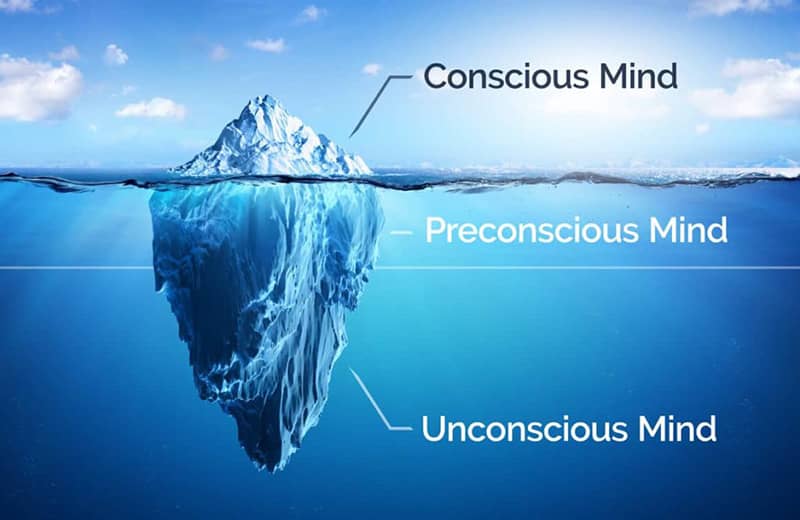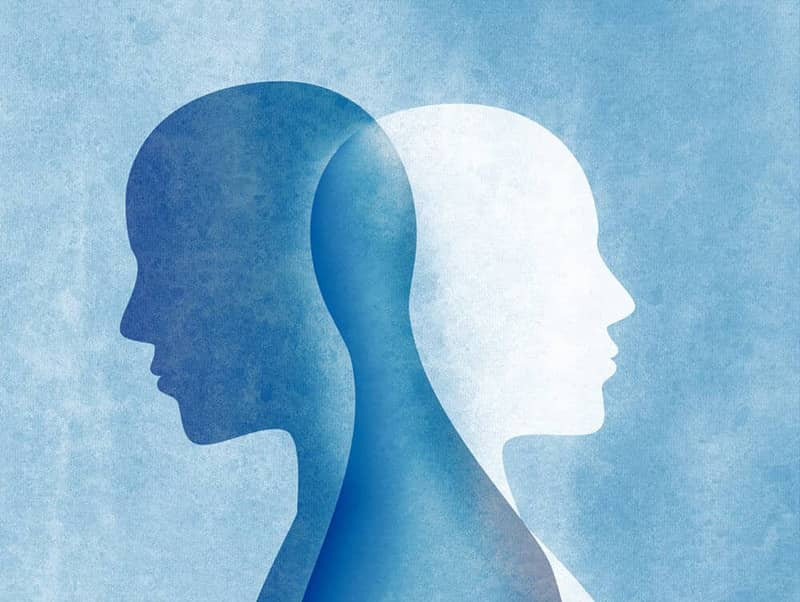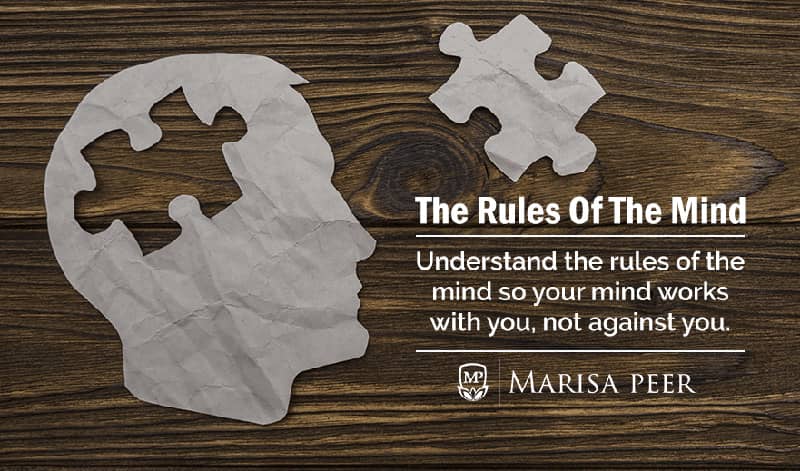How Aur Conscious Mind Differs From Other Animals
Are you lot aware of the differences between your witting and subconscious listen? This commodity explores the theories of both the conscious and subconscious. It also explores other variations, including the preconscious and unconscious mind. It uncovers the battles your mind goes through and how to achieve your goals by tapping into the correct entity.
Consciousness vs Subconsciousness. Discover what these parts of the heed are responsible for with enquiry into the theories of Sigmund Freud, Marisa Peer, and more.
In this commodity, you lot will learn:
- The Sigmund Freud Theory of the Mind.
- The Boxing of the Conscious vs the Subconscious Heed.
- The Power of the Hidden Mind.
- Marisa Peer's Rules of the Listen.
- and Hypnosis and The Subconscious Heed.
Let'south become started with Sigmund Freud'due south theory of the heed.
Sigmund Freud Theory of The Heed

Sigmund Freud advocated the illustration of the iceberg in the sea. He quoted: 'The listen is like an iceberg; information technology floats with ane-seventh of its bulk to a higher place h2o.' His theory was that the mind has 3 parts: the conscious (higher up water), the preconscious (just below the waterline), and the unconscious (way beneath the waterline).
Psychology author, Kendra Cherry, reviews Freud'due south model of the mind:
'The famed psychoanalyst believed that behavior and personality were derived from the constant and unique interaction of conflicting psychological forces that operate at 3 unlike levels of awareness: the preconscious, witting, and unconscious. He believed that each of these parts of the heed plays an important role in influencing behavior.
In order to understand the ins and outs of Freud's theory, it is essential to outset empathize what he believed each part of personality did. This includes how it operated, and how these three elements interact to contribute to the human experience. Learn more than nearly each of these levels of awareness and the role that they play in shaping human behavior and thought.
The Three Levels of Awareness
- Conscious heed: This contains all of the thoughts, memories, feelings, and wishes of which we are aware at any given moment. This is the aspect of our mental processing that we tin call back and talk about rationally. This too includes our memory, which is not ever role of consciousness but tin can be retrieved easily and brought into awareness.
- Preconscious: This consists of annihilation that could potentially be brought into the conscious mind.
- Unconscious (or subconscious) mind: This is a reservoir of feelings, thoughts, urges, and memories that are outside of our conscious awareness. Most of the contents of the unconscious are unacceptable or unpleasant, such as feelings of hurting, anxiety, or conflict.'
Psychology tutor, Saul McLeod, explores further into Freud's iii levels of the mind.
Saul Mcleod:
'Freud described the witting mind as consisting of all the mental processes of which we are aware, and this is seen as the tip of the iceberg. For example, you may become aware of feeling thirsty so y'all decide to get a drink.
The preconscious contains thoughts and feelings that a person is not currently enlightened of, merely which can hands be brought to consciousness. It exists just below the level of consciousness, before the unconscious mind. The preconscious is like a mental waiting room. Thoughts remain until they succeed in attracting the centre of the conscious.
This is oft referred to as available memory. For example, you are presently non thinking about your mobile telephone number, but at present information technology is mentioned you lot tin can call up it with ease. Mild emotional experiences may be in the preconscious, just sometimes traumatic and powerful negative emotions are repressed and hence not available in the preconscious.
According to Freud, the unconscious mind is the primary source of human behavior. Like an iceberg, the about important part of the mind is the part you cannot run across. Our feelings, motives and decisions are actually powerfully influenced past our past experiences, and stored in the unconscious.'
Conclusion of McLeod
McLeod'south explanation clarifies the unconscious heed contains not only negative thoughts from by experiences, but also your deepest desires.
How do you lot describe your subconscious mind?

Freud'due south theory does non take into account the entity of the subconscious. This part of the listen is regularly referred to in therapy.
What is an example of subconscious mind?
Examples of your subconscious mind include fears, beliefs, desires, and memories that you may not exist enlightened of. Only some of these tin be accessed with some work, such every bit therapy.
Self-Development Author, Brian Tracy, summarises the importance of the subconscious mind:
'Permit'due south outset take a moment to consider the fact that your subconscious mind is similar a huge memory bank. Its capacity is virtually unlimited and information technology permanently stores everything that ever happens to you. By the time you attain the age of 21, you've already permanently stored more than 1 hundred times the contents of the entire Encyclopedia Britannica.
Under hypnosis, older people tin can ofttimes remember, with perfect clarity, events from fifty years earlier. Your unconscious retention is virtually perfect. It is your witting recall that is suspect.
The function of your subconscious mind is to shop and recollect information. Its job is to ensure that you respond exactly the manner y'all are programmed. Your subconscious mind makes everything you say and practise fit a blueprint consistent
With your self-concept, your "main program." This is why repeating positive affirmations are so effective―y'all can actually reprogram your ain thought patterns past slipping in positive and success-oriented sound bites.'
The subconscious and unconscious mind are used interchangeably. Michael Craig Miller, M.D. in an article for Harvard Wellness explains why.
Michael Craig Miller:
'The term "unconscious mind" is nearly closely associated with Freud and psychoanalysis. For Freud, information technology was a cardinal element of the theory he was developing to explain the causes of mental disorders and how to treat them. Put in the simplest terms, Freud theorized that hidden mental contents were making people "ill." Equally he understood it, these mental contents had been "repressed" and made unconscious.
As for the term "subconscious," Freud used it interchangeably with "unconscious" at the outset. But he eventually stuck with the latter term to avoid confusion. He couldn't take predicted that the defoliation would still exist subsequently more than 100 years of discussion.
Every bit a general rule, in most of the professional literature where mental operation is concerned (including not simply psychoanalysis, just too psychiatry, psychology, and neuroscience, amid others), writers—similar Freud—tend to use the word "unconscious" rather than "subconscious." Still, due to the literal definition of unconscious being when a person passes out, the term subconscious is often used instead as a preference.'
The Battle of the Conscious vs the Subconscious Listen

How exercise y'all use your conscious and subconscious mind together?
Quite oftentimes, your mind can be torn between the behavior of your conscious and your subconscious. This article past investment manager Ray Dalio on Linkedin explores why this happens.
Ray Dalio:
'Equally with animals, many of our controlling drivers are below the surface. An animal doesn't "decide" to fly or hunt or slumber or fight in the way that nosotros go almost making many of our own choices of what to do—it simply follows the instructions that come up from the subconscious parts of its encephalon. These same sorts of instructions come to the states from the same parts of our brains, sometimes for good evolutionary reasons and sometimes to our detriment. Our subconscious fears and desires drive our motivations and actions through emotions such every bit honey, fearfulness, and inspiration. Information technology's physiological. Love, for example, is a cocktail of chemicals (such as oxytocin) secreted by the pituitary gland.
…I also came to sympathise that while some hidden parts of our brains are dangerously animalistic, others are smarter and quicker than our conscious minds. Our greatest moments of inspiration often "pop" upwardly from our hidden. We feel these artistic breakthroughs when we are relaxed and non trying to access the role of the encephalon in which they reside, which is more often than not the neocortex. When y'all say, "I just thought of something," y'all noticed your subconscious mind telling your conscious heed something. With training, it's possible to open this stream of communication.
Many people only come across the conscious mind and aren't aware of the benefits of connecting information technology to the hidden. They believe that the mode to accomplish more is to cram more into the witting mind and make it work harder, but this is often counterproductive. While it may seem counterintuitive, immigration your caput can be the best manner to make progress.'
Conclusion of Dalio'south Theory
Dalio's theory gives relevance to the feeling of procrastination. Sometimes, when you lot relax and put things off for a while, you sometimes go a 'lightbulb' moment out of nowhere. It is in fact, your subconscious saving the day.
The Power of the Subconscious Mind

Whether you are awake or asleep, your subconscious heed is recording and storing everything. Thanks to your stored memories, feelings and desires, your subconscious plays a huge role in the creation of your dreams. This commodity on The Wisdom Post explains how it works.
The Wisdom Post:
'When yous fall comatose, it is your conscious listen that is sleeping. Notwithstanding, your subconscious mind will never fall comatose. It works 24 hours a twenty-four hour period fifty-fifty when you lot sleep. Your subconscious mind is controlling your torso, your breathing, your organs functionality, your jail cell's growth and everything. This is why when yous sleep, your hidden mind is still wide awake. And that simply ways that it is your unconscious mind that is solely responsible for your dreams.
This is the point where your hidden heed connects with your mental images that produce what we call, dreams. And considering our subconscious heed thinks in the form of symbols, metaphors, and visual forms, our dreams tend to be projected in that way likewise. This is why most dreams are indirect and difficult to empathize, only they are oftentimes connected to our experiences and the events in our daily life.'
Marisa Peer's Rules of the Mind

In this Rules of The Mind article, psychology adept Marisa Peer explains that the outset uncomplicated job your heed has is to keep yous alive for as long as possible. To practise that, your hidden mind will motility yous away from hurting and towards pleasure. It is highly influenced by the words yous say and the pictures you imagine. Your listen loves what is familiar and prefers to avoid annihilation unfamiliar.
Hypnosis and The Subconscious Mind
Hypnotherapy taps into the subconscious mind, oftentimes to bring out deep-ridden traumas from childhood or past events that have left feelings of negativity. The hidden is thought of as a biological hard-drive. Or like a recorded database for all things about y'all. Your witting mind may know that y'all should quit that unhealthy habit, or exercise more often. But this conscious willpower can only guide you so far. It's the subconscious that needs rewiring in order to attain your goals. Why? Because your subconscious beliefs can demolition your conscious efforts. The more enlightened yous are of your hidden beliefs, the better yous will go at accessing them.
You can oft tap into the subconscious mind in instances where you feel a 'gut instinct' or intuition. The more you pay attention to this, the meliorate you will be at preparation your subconscious.
Marisa Peer has helped many clients achieve success in their lives through her unique technique of reprogramming the subconscious mind, called Rapid Transformational Therapy™ (RTT). Based on the scientific discipline of neuroplasticity, RTT combines the most beneficial principles of Hypnotherapy, Psychotherapy, NLP, CBT, and Neuroscience.
Interested in Exploring your own Hidden Mind?
If yous loved this article and want to explore the subconscious mind even further, you can check out the Marisa Peer sound store , where you can discover a huge range of audios, and audio bundles to explore. Marisa Peer is a world-renowned therapist with over 30 years of feel, and has trained more than 6000 people in her ground-breaking RTT technique. She has developed these audios through her extensive cognition – read on to find out more than.
Marisa Peer Hypnosis Audio Downloads
You tin listen to Marisa Peer'due south audios from the condolement of your own dwelling house. The range features powerful words by Marisa that directly address your hidden to help you lot overcome addictions, reach your goals, improve your personal traits, or attract relationships. Marisa recommends listening to them every day for a minimum of iii weeks. Click the image beneath to browse the audio shop.

If you enjoyed reading this article, please share it on your social media channels. We would also dear for yous to sign upwardly to our complimentary Wellness Weekly digest by registering using the course at the lesser of this page. Wellness Weekly is packed full with insightful articles, useful resources, free gifts, inspiring quotes, and real-life stories. Information technology'southward enjoyed by over 10k readers and is the perfect pick-me-up for your weekend.
Source: https://marisapeer.com/the-differences-between-your-conscious-and-subconscious-mind/
Posted by: simsthicalin.blogspot.com

0 Response to "How Aur Conscious Mind Differs From Other Animals"
Post a Comment